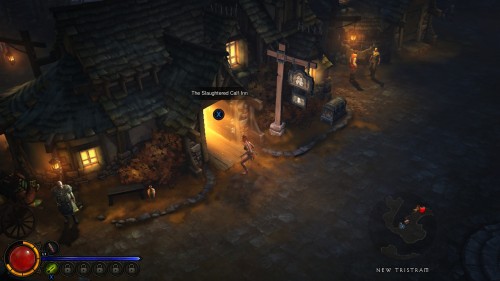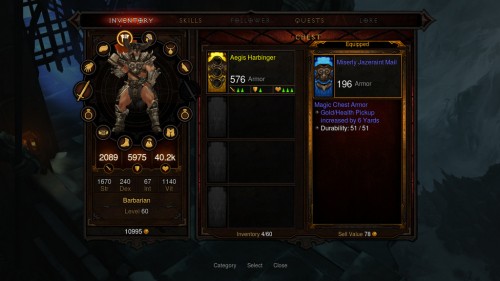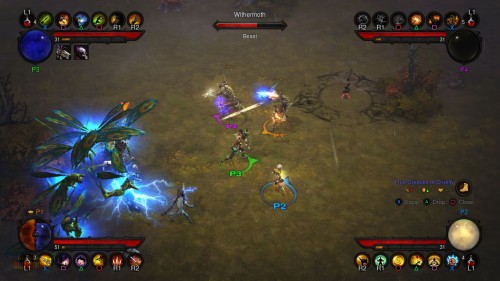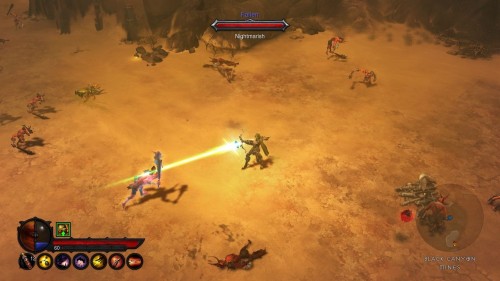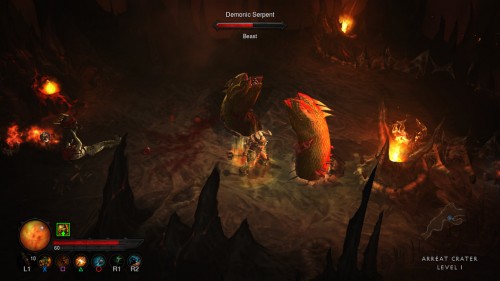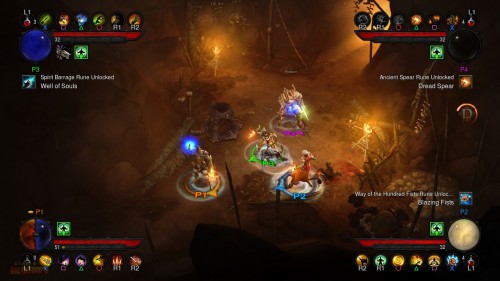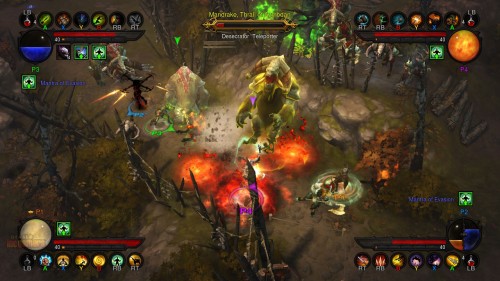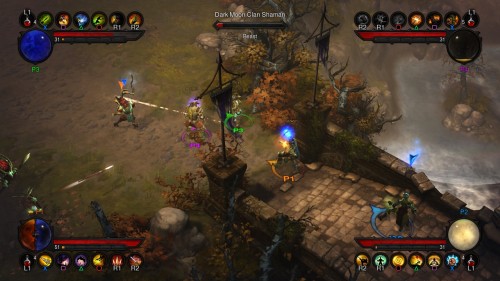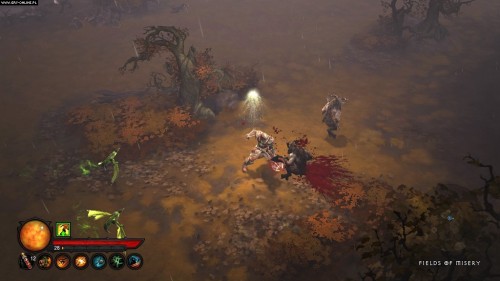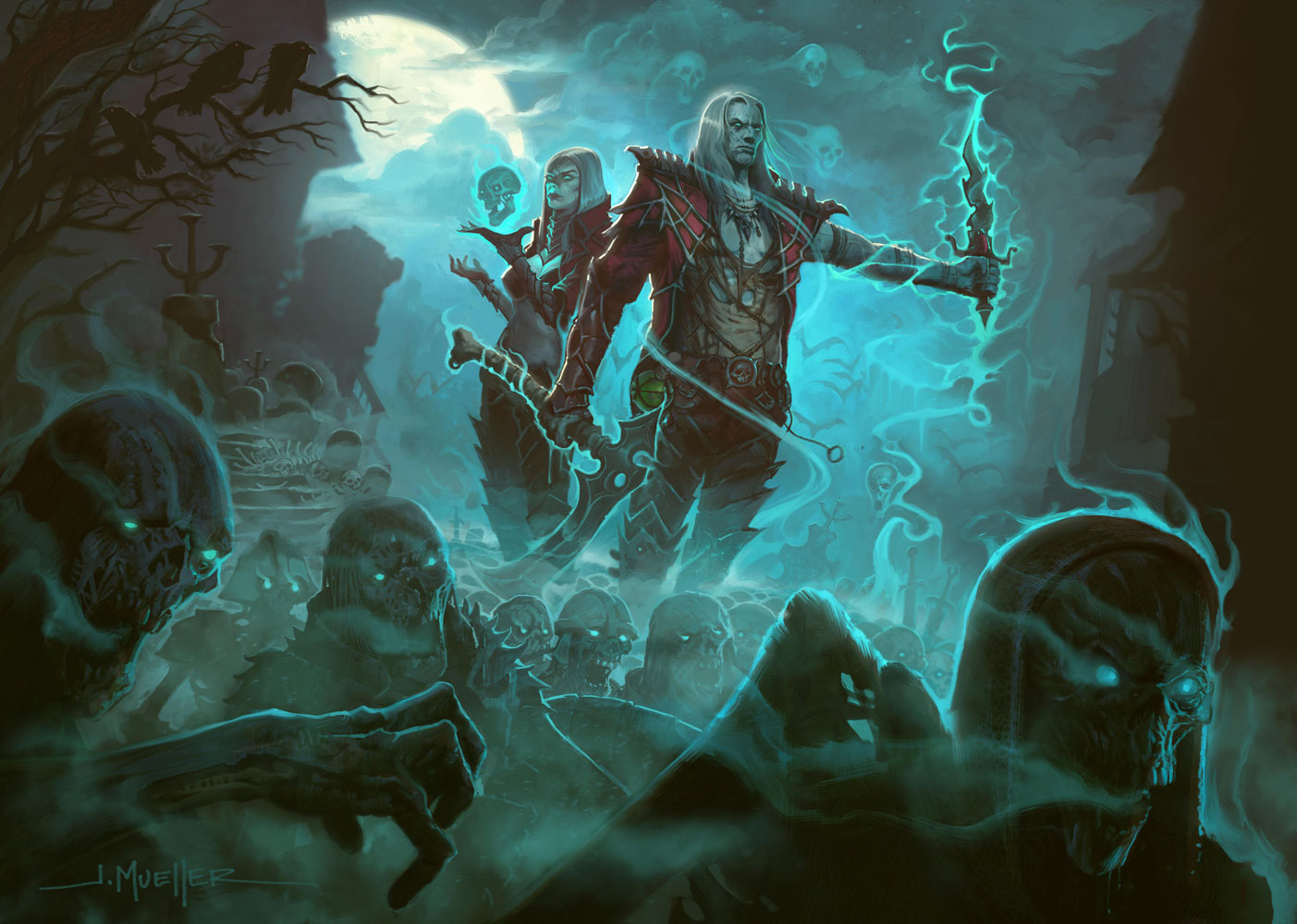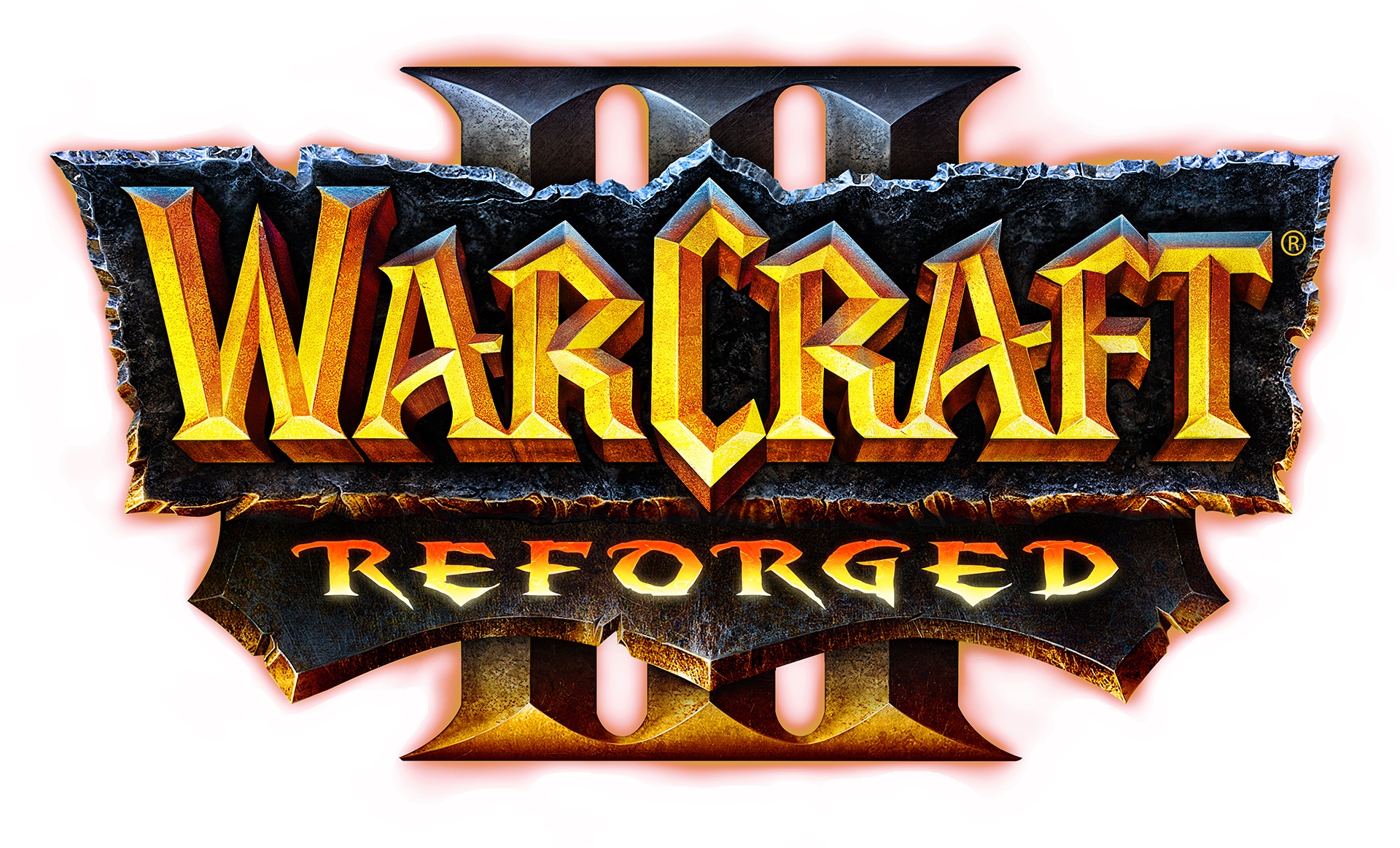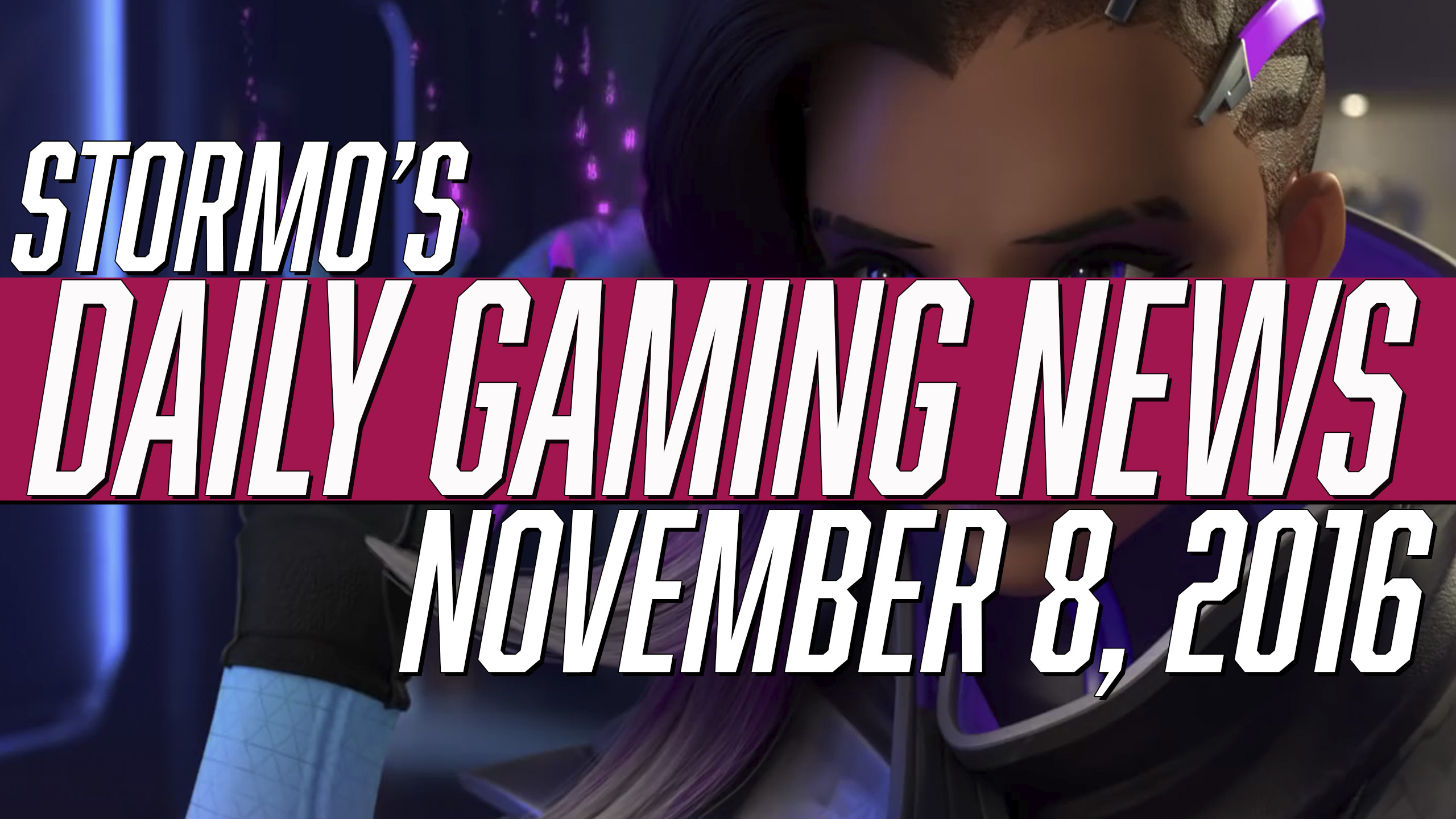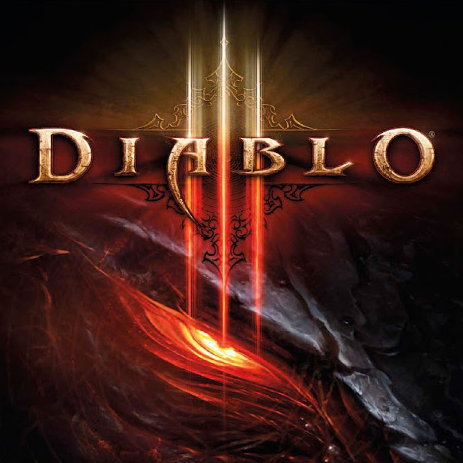
It’s easy to forget, these days, that Blizzard started out making console games. Their earliest tiles included SNES classics Rock’n’Roll Racing, BlackThorne and The Lost Vikings. After hitting it big with Warcraft and Diablo, the company shifted to focus on the PC market, producing the mega-successful Starcraft as well as sequels to Warcraft and Diablo. Even so, they never quite forgot about consoles— Diablo found its way to the PlayStation, and Starcraft got a surprisingly decent Nintendo 64 port.
With that in mind, a long-awaited return to consoles for the studio isn’t as surprising as it might be. The announcement of Diablo III for consoles soon after the launch on PC last year seemed more like an inevitability rather than a surprise. Blizzard’s efforts at streamlining and simplifying the PC version almost felt like they were planning the game for console from the start, and while they have denied this, it’s hard, playing it on the PS3, to feel otherwise.
The good news about Diablo III for console is that this is the full Diablo III experience. Every level, every cutscene, every quest, every secret has made it in. The few compromises that had to be made to support the unique architecture of the PS3 and XBox 360 have no impact on the overall quality of the game. Diablo III is as good on console as it has ever been on PC.
In fact, its even better for reasons which I’ll get to soon. For the remainder of this review, I’m going to take a look at the differences between the two versions. If you want my overall thoughts on Diablo III, my review from last year still stands.
The most obvious difference is the controls. The switch to console necessitates a switch in control schemes. You now have direct control of your character with the left analogue stick on the controller, while the right stick functions as a multi-directional dodge. This is a new feature to the console version, and it works very well, ensuring you can generally get out of a tight spot with ease. There’s no cost to dodging other than interrupting any skill you were casting, and learning to use it will be key to surviving on the higher difficulties.
Skills are activated from the controller buttons with X being assigned to your primary skill and R2 being assigned to your secondary skill (XBox 360 players can substitute as appropriate here). I was a bit worried about how this would play out at first, but it quickly became second nature. The other face buttons and R1 all get assigned to the skills that would be assigned to the 1–4 keys on the PC version. The overall combination works incredibly well and you never feel limited by not being able to use a mouse and keyboard. I actually wouldn’t mind seeing controller support added to the PC version.
The menus and user interface have been completely redesigned, and this will be the most obvious visual difference from the PC. the action bar has gone away, and the health/resource orbs have been moved to the corner of the screen. Health is now represented by a bar rather than an orb, which I find a lot easier to read. Again, I’d love to see this as an option on the PC. Experience is shown under the health bar, and currently assigned skills are shown below this.
The inventory, vendor and crafting screens have all been completely reworked. They all share a new rotary menu system that is categorised by equipment slot. The “Tetris inventory” from the PC is gone, and there’s now a simple hard cap (60) on inventory items. Skills, the party menu and the quests and lore menu have all been integrated into the same screen as the inventory.
The vendor menu is similar in setup, however be warned that it can be a little to easy to lose your place and accidentally buy something when you intended to sell. Overall, I like the new design and it works well given the need to adapt for the controller. There’s also a ‘quick inventory’ system where you can cycle through items you’ve picked up and quickly equip them without needing to use the menu screen.
When you pick up an item, Diablo III provides a quick view of whether it offers better stats in three categories (damage, armour and health), which will allow you to quickly determine if you want to equip it or not. This works best in conjunction with the quick inventory.
The biggest changes to Diablo III on the console are much less obvious, but they work out to make the game better than the current PC version. The most important of these is the loot system. As time went on after the game’s launch last year, it became clear that there was a problem with the quality of loot, and the frequency of loot drops relevant to your character. This has mostly been blamed on the auction house, and the idea that to properly equip a character, you will need to use the auction house.
The console version solves these problems in a few ways. Most obviously, there’s no auction house, so there’s no need to itemise the game in order to drive auction house use. The flow-on effect from this is that the quality of items that drop are dramatically improved. The probability of getting items you can use is much higher and upgrades drop a lot more frequently. Interestingly, the amount of loot that drops is actually reduced, and the game will even convert low-quality loot into gold automatically so you never see it.
PC players may be thinking that this is Loot 2.0, a long-promised overhaul of the PC loot system. According to Blizzard, it is inspired by Loot 2.0, but doesn’t incorporate all of the features planned for that overhaul. As it currently stands, though, the dramatic improvements in loot are enough to put the console version ahead of the PC version right now. That’s right: if you want the definitive Diablo III experience, get the console game.
The other major underlying change is to do with enemy behaviour. Because of the much more limited hardware (compared to a modern PC) of the consoles, it would be impossible to throw the vast numbers of enemies at you that the PC version can. Simply reducing the number of enemies you fight won’t work, as it would make the game a lot less fun to play.
Blizzard’s solution then is to alter the behaviour of enemies so that, overall, you’ll see roughly similar densities on each difficulty, however you’ll end up fighting fewer enemies at a time. This is because mobs will come at you in waves now, with new waves coming in as you finish previous ones off. The effect is subtle, and you’re unlikely to notice it at all until you start hitting the higher difficulties. It’s done in such a way that you should still be able to rack up huge massacre and mighty blow bonuses.
To make life easier on players, a new buff called Nephalem Glory has been added. This buff appears in the form of gold orbs (similar to health orbs) that occasionally drop from monsters. Once active, the buff increases your movement speed and causes your attacks to occasionally trigger bursts of energy that hit multiple enemies for large amounts of damage. I’m not entirely sure of the reasoning behind this addition, but it can make clearing huge enemy packs, and tricky champion and elite packs a lot easier. The buff has three stacks, with each increasing the potency of the effect. Picking up health orbs extends it beyond the initial sixty second time limit. Also note that this is not the same as the Nephalem Valor buff from the PC version.
I should also note that Diablo III on console does not require an internet connection as the PC version does. While I was always okay with the always online requirement of the PC version, I did find the latency between pressing a button and its attack firing to be sometimes frustrating, especially in situations where that difference was a matter of life or death. Well the console version has none of this. Pressing a button triggers an attack with no latency, and you feel much more in control as a result. No more losing arguments between the server and the client, either.
One of the most hotly anticipated features of this version is the offline multiplayer. Diablo III allows for up to four players to play locally. You can also use a mix of any combination of up to four local or online players, too. The local co-op works incredibly well, and playing it with a group of friends can be really fun.
In our play session, we did note a number of caveats that any group wishing to play the game like this needs to be aware of. First off, when one player brings up a menu screen, that locks everyone else out of moving until they finish, as does using the vendor and crafting interfaces. The other thing to note is that loot that drops is available for everyone to pick up. This can be problematic, especially for classes like the Monk and Barbarian, who are both melee attackers, and who’s X button is used both to pick up loot and to attack.
We found, as a group, that the best way to play was to approach the game as though it was a D&D campaign with the PS3 acting as the DM. We always made sure to give a warning when we had to use the inventory screen, and we soon got very good at using the quick-equip option on the DPad. To ensure you never lose which character you are on the screen, clicking the right analogue stick will cause a beam of light to appear above your character.
Overall, the co-op is really fun, but you’ll definitely want to make sure that all players are on a level with what’s going on and ready to take turns at things like assigning skills and using crafting. We found progress was fairly slow-going (in an afternoon, we got as far as the Skeleton King in the first act). The group I played with is relatively familiar with RPGs (and three of us are ex-WoW players) so it didn’t take long for the others (who are not D3 players) to pick up on what was going on with skills and equipment. I genuinely think this is going to be a big selling point for the console version of the game, and it’s definitely a brilliant addition.
There’s some other notable changes to the game for the console release as well. First off, PC players should note that this is based primarily on the 1.0.7 version of the game, with a few things backported from 1.0.8. This means that some conveniences, like the Book of Cain for identifying large numbers of items at once are absent. That said, only legendary items need to be identified in the console version, so the ritual of returning to town and spending a while identifying all those rare items in your inventory is mitigated.
Two of the major boss fights have been significantly overhauled as well. Belial is the biggest change. PC players will know that the game zooms out somewhat for this fight, allowing you to better see the area you’re fighting in. As it’s not possible to zoom out this much in the console version, the camera instead switches to a behind-the-player view. It’s a little surprising at first, but ends up working out well for what is probably the most challenging fight in the entire game. The fight itself has been simplified somewhat, although the major elements from the PC version are all still there.
Azmodan hasn’t been changed as dramatically, however you no longer start fighting him on the pool of lava. He blocks off a significant portion of the chamber you encounter him in, and the mechanic where he floods the room with pools of dark death has been altered so the pools begin from a series of objects that form the barrier that limits where you fight him. As with Belial, this simplifies the fight somewhat, however the change is definitely beneficial.
The final major change is in how difficulty works. The standard Normal/Nightmare/Hell/Inferno difficulties are still there, however Monster Power has been replaced by selectable difficulty levels when you start a game. These levels are Easy, Medium, Hard, and Master 1 through Master 5. As with monster power, they offer increased chances at better loot and other items in exchange for much tougher monsters. Medium is the default, and feels most like the PC version without monster power.
Visually, Diablo III on console is a necessary step back from the PC version. It feels like playing with the texture quality and filtering turned down a notch. The camera has been zoomed in somewhat, too, which is beneficial when playing on a TV from a distance. The enemy AI takes this zoomed view into account when fighting, so you’ll never be in a situation where you are engaging monsters you can’t see. All the physics effects are still in place, so monsters and debris still go flying everywhere as you kill them, and most of the spell effects look roughly the same. On-screen text is mostly rendered in Helvetica rather than the classic Exocet typeface that is synonymous with the series.
As it stands, the console version of Diablo III is the definitive version of the game. The improvements to the loot, coupled with offline gameplay and a really well-implemented local co-op mode help make this feel much more like the game that Blizzard promised it would be in the years leading up to the launch. Most importantly, the underlying experience hasn’t been compromised at all in the transition to the TV screen, so you’re getting everything that PC players have enjoyed for over a year now, and then some.
If you’ve never played Diablo III, then I strongly recommend taking a look at the console version. You’ll be getting a very well-made dungeon crawling experience with huge replay value and rewarding multiplayer modes. For PC owners, it may be a slightly tougher sell: while it stands as a better version of the game overall, future patches will add many features to the PC version that are already in this version. On the other hand, it seems unlikely that the PC version will ever get offline play and local co-op (although I can see controller support being added to it as an option at some point), so if you want those features, then you’ll have to double-dip.
Also keep in mind that while Diablo III is available for the PS3 and XBox 360 right now, it will also be coming to the PS4 and XBox One next year, and those versions will likely be better supported in the long-term. Expect a similar experience with PC-quality graphics when they launch. It’s also worth pointing out that the upcoming expansion, Reaper of Souls has not yet been announced for consoles, and will definitely put the PC version ahead again once it’s out.
With all that in mind, I think that what Blizzard have done here is amazing. Translating a game like this without compromising its best attributes takes a lot of careful planning and design. To pull it off as well as Blizzard have is testament to the studio’s skill, and proof that they are capable of anything they want to do, regardless of the underlying platform. If you do decide to pick this up, you’re in for something very special, regardless of whether you played the PC version or not.
- Perfect port from the PC
- Improves on the PC in some areas, including offline play and improved loot
- The definitive Diablo III experience right now
- Longer loading times, and no install option on the PS3 disc version
- Will likely fall behind the PC version as patches and expansions come out
Overall Score:
Diablo III
August 11, 2013
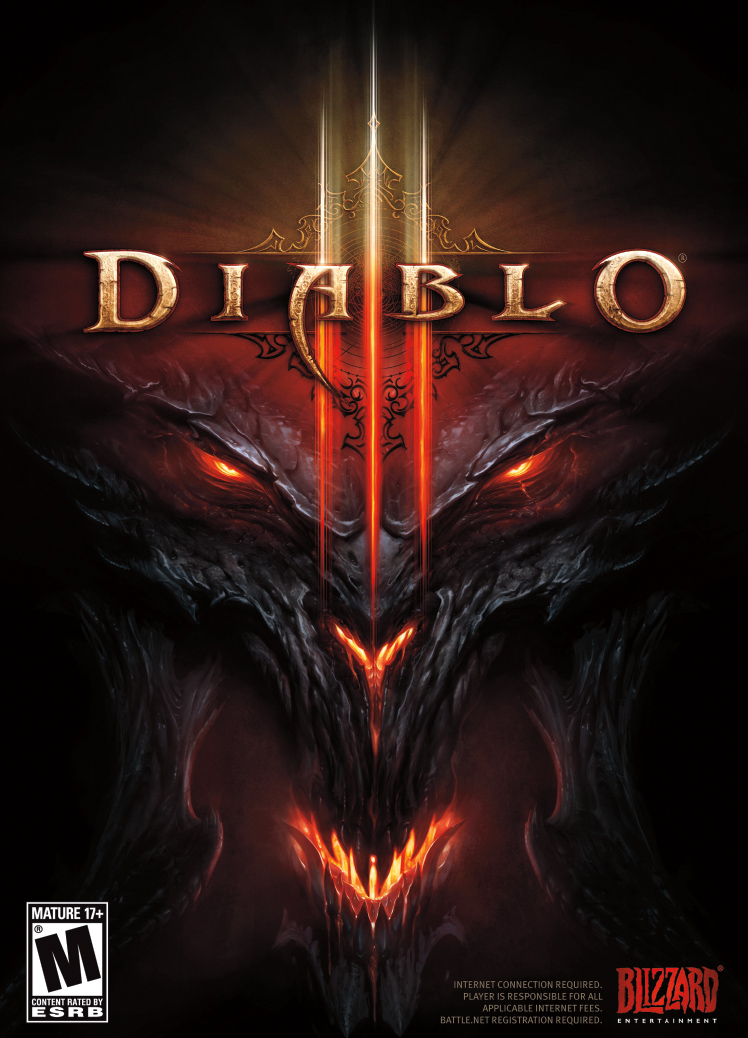
There is something special that happens the first time you start up a Blizzard game. Maybe it’s because, outside of World of Warcraft expansion sets, they release a new title so rarely, or perhaps it’s simply because they have a reputation for quality that is unmatched by anyone in the industry.
So you can imagine the excitement when, back in 2008, Blizzard announced it was going to make a newDiablo game. This followed the surprising announcement the previous year of a sequel to their 1998 RTS classic, Starcraft.
It’s important to remember that a Blizzard game doesn’t have the lifecycle of the typical video game release. They support their games for many years after the launch. The original Starcraft still receives updates, fourteen years after launch, and Diablo II can still be played online, twelve years on. Compare that to relatively recent games that have their servers taken down just a couple of years after release. Longevity is built into the cover price of a Blizzard game.
So as Diablo 3 loaded and I made my first mouse clicks, I already knew I was playing something special, something that I would come back to for many years ahead. The visuals, even in this starting area, are typical Blizzard. Detailed down to individual leaves on the ground, with a carefully chosen palette that’s deliberately designed not to get in the way of the action.
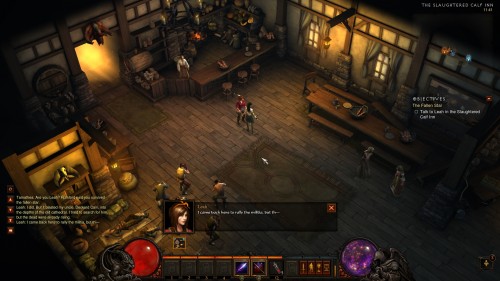
They could have chosen to give the game a free-moving camera. The original games used the isometric view out of necessity: they existed at a time when 3D graphics weren’t a ubiquitous feature of most PCs. Now, in an age where even mobile phones have more processing power than was needed to run Diablo II, Blizzard have chosen to maintain the view because it’s integral to the Diablo experience.
Similarly, Blizzard have chosen to keep the “click things until they die” control scheme. They could have gone with a WASD setup, or even Xbox controller support (and third-party tools allow just such a thing to happen), but they know that people who play Diablo prefer to play it by clicking the mouse to move and kill things. They’ve beefed it up, however, thanks to changes in the way skills work, and also in the way each class’ resource system operates.
These things show that Diablo III is a reconstruction of the earlier titles. A modernisation that both recalls and updates the older games to meet modern expectations. The super-streamlined skill system, the removal of the illusory choices in stat point allocations, and the fact that each class has its own resource system show that Blizzard is moving the entire genre forward, without alienating the people who have put so much time and effort into the previous games.
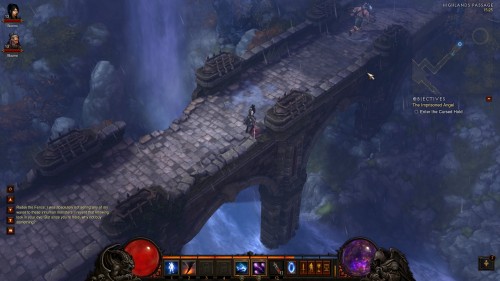
One thing I really love about Diablo III is that each of the game’s five classes feel different and unique to play. The Barbarian is the most traditional, and the one that will be most familiar to Diablo II players. It’s a simple warrior-type, with a resource called Fury that builds within combat, and then degrades outside of it. Then there’s the Monk class, which, despite also being a melee damage dealer, offers up healing and damage-taking abilities that make it feel more like a mixture of the Paladin and Rogue classes from World of Warcraft.
Despite both classes being melee damagers, Monks and Barbarians feel completely different to each other, thanks to the way their resources build and deplete in combat. The same is true of the other three classes as well. Demon Hunters use a split resource system, with Hatred fuelling their offensive abilities, while the slower-regenerating Discipline fuels more defensive abilities such as a combat vault and caltrops. They are weak up close, but can deliver the goods when standing far enough away.
Wizards and Witch Doctors are the two classes that are most similar to each other. They both use a fast-regenerating resource (called Mana for Witch Doctors and Arcane Power for Wizards), but the way they spend that resource is different. Witch Doctors can do things like throw jars of spiders into the crowd (I’m not even kidding, this is an actual thing they do), or shoot bats that are on fire from their hands. Wizards, on the other hand, shoot elemental rays of frost or lightning or fire. It’s possible with the right gear and skill setup, to create a Wizard that is viable in melee combat.
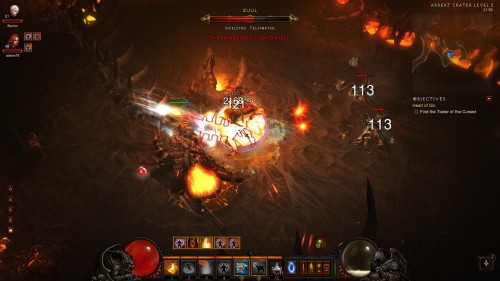
Another interesting aspect of Diablo III, and something that might surprise, say, a World of Warcraft player that is used to heavy restrictions on what gear their class can equip, is that there are only a small number of gear restrictions for each class. Monks can’t equip two-handed swords, for example, but they can equip basically anything else, including shields. In fact, even Wizards and Witch Doctors can equip shields if they so desire. There are some items that are restricted to specific classes (fist weapons are Monk-only, for example) but these are less common, and nothing says you have to stick to them. Hell, I had a Crossbow-wielding Wizard for some time due to the stats the crossbow gave her.
This couples with the skill system to add even more flexibility and customisation to a character. There’s very few things that won’t work well (at least, not until the later difficulty levels) for somebody out there. In groups, having more than one of the same class doesn’t mean they will play anything alike, and its fun to watch, say, one Monk pull out huge amounts of healing while another relies heavily on area-of-effect damage dealing.
This would all be pointless if there was nothing interesting to do in the game. But this is a Blizzard game, and they don’t do boring content. The areas and dungeons of Diablo III are nothing short of spectacular to look at. If you’ve only seen screenshots of the beta, you might be forgiven for thinking that red and brown and some darker blues are the colour palette for the entire game. But after you down the first minor boss of the game (which is where the beta ended), the world opens up, and you get to see some fantastic scenery. From high stone bridges, a vast desert, busy city streets and snow-bound battlefields to dark caves, vast torture chambers and the hellish interior of a shattered mountain, every location in Diablo III is stunning to look at.
It shouldn’t come as any surprise, of course. Blizzard are, after all, artists, and the art for their games is the best in the industry. Diablo III looks this good because they don’t know how to do it otherwise. Hell, eight years on, World of Warcraft still looks great thanks to their clever artistic choices early on in the game’s development. By avoiding detailed and realistic visuals, Blizzard’s games have a timeless look that helps with their longevity. The only reason Diablo II looks dated is because nobody has a monitor that’s of low enough resolution to make it look anything less than a pixelated mess. 3D art won’t have that problem, soDiablo III will look just as good in twelve years as it does today.
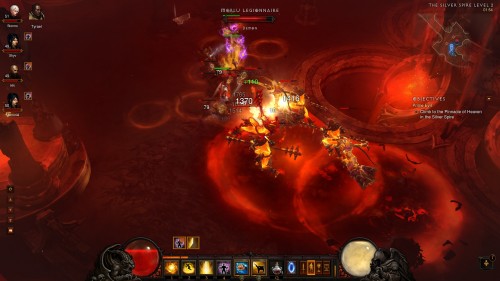
I probably shouldn’t have to go into the music too much. Russell Brower has been making fantastic music for Blizzard games since The Burning Crusade, so you know you’re in good hands here. While his music is completely optional for much of the game, it’s worth having a play through with it turned up at least once. Some of the music for the previous titles (namely the Tristram theme) have been recreated here, and it sounds great.
All this brilliance might make Diablo III a near-perfect game. There is, however, an elephant in the dungeon crawler. If you don’t have an internet connection, you absolutely cannot play Diablo III. Even the single-player mode requires an online connection. If the servers are down or under extreme load, like they were at launch, then you won’t be able to play at all. The good news is that, Blizzard being Blizzard, the online functionality of Diablo III is unlikely to disappear anytime soon. As long as people keep playing it, it will be there to play. So that’s not a concern.
What is a concern with this setup, however, is the intermittency and reliability of people’s internet connections. The fact is that Australian players are going to have to put up with a few hundred milliseconds of latency even when playing solo. This can be frustrating, as any WoW player knows: the time between firing off that saving heal or attack and it actually landing can be enough for the enemy to drop the killing blow. On more than one occasion, I’ve died despite hitting my healing potion in time to live, due to latency. In a game that requires split-second timing to survive, this is problematic.
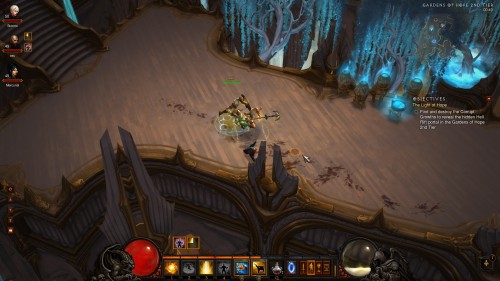
While it’s easy to get angry on the internet at the decision to make Diablo III all-online all the time, the issue is a lot more complex than that. Firstly, Diablo II is riddled with hacks and exploits that players have been using to duplicate items and easily gain things that should be difficult to get. Requiring an internet connection to play the game resolves a vast majority of this kind of issue, as every item that drops is verified by the server.
This is important for the big reason behind the move: The auction house. Diablo III allows, for the first time in the history of the series, players to trade items between each other on an online auction house system.WoW players will already know how this works, but there’s a few differences in the Diablo III world.
First and foremost, there’s no such thing as ‘soulbound’ items in Diablo III. In WoW, a soulbound item is one that cannot be traded to other players. This was implemented originally to keep WoW’s economy from being flooded with high-value items and quest reward items. Because Diablo III isn’t a persistent world, there’s no need for this restriction. The added bonus for players here is that it’s entirely possible to simply sell an item on the auction house once you receive an upgrade to it.
More importantly, (and here we come to the core of the always online requirement), there is (or will be, when Blizzard enable it) an Auction House that uses real money to purchase in-game items. This is a bold step for Blizzard, who’s campaign against real money transfers in WoW are well-documented. Diablo III makes a good testbed for this system, however, as there’s less need for the strict item requirements that WoW has.
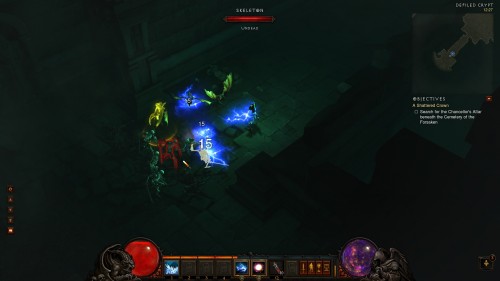
Officially sanctioning such a thing effectively strangles any kind of illicit item trade (of the kind that plaguesWoW) at birth. It’s hard not to think of this as a test for a similar system in World of Warcraft (or Project Titan, an as-yet unannounced MMO not related to any existing Blizzard franchise) at some point in the future. It will also be how Blizzard makes money on Diablo III once sales die down. As there’s no online subscription fee, taking a small cut of the real money auctions is how the company intends to keep the game profitable.
I have no doubt that this is the primary reasoning behind the online requirement for Diablo III. And, to be quite honest, as much as the pain of launch week has shown up the inherent flaws in this system, I don’t believe that, in the long run, the system will hurt the game at all. Blizzard are Blizzard, and they have built their reputation on getting things right quickly. Is it problematic now? Yes. Will there be issues with it in the future? Most likely. Will most players care in a year’s time? No. It’ll just be part of the way this game is played.
In the end, Diablo III is going to be remembered as a bona fide classic. Blizzard excel at making very good games, and Diablo III is absolutely a very good game. I’ve avoided talking about the story so as not to spoil it, but I will say that it mostly exists to hang the rest of the game around. The CGI cutscenes are well-directed, and the characters are as engaging as they need to be. Really, though, nobody is playing this game for the plot. Diablo III is, like any game of this kind, all about the clicking and the looting and the being awesome. Quests give you goals and targets to get through, but they very deliberately avoid getting in the way of slaughtering horde after horde of demons.
Finally, a word about difficulty levels. For this review, I played the game through on both Normal and Nightmare difficulty. Normal actually felt a bit underwhelming, and I was really wondering if I was playing a game as good as I was hoping it would be. However, ramping up to Nightmare revealed the true nature ofDiablo III, and the overall experience is vastly more satisfying. Finishing it has only made me want to go through Hell difficulty even more. There’s a final difficulty level beyond Hell, too. Called Inferno, it’s designed for level 60 characters only (60 being the maximum level in Diablo III), and offers a way of keeping max level characters coming back time and again.
All of this ensures that Diablo III is set to become another Blizzard juggernaut. There will be pretenders and challengers to its crown, but they will have to do a lot more to come close to what Blizzard have done here. This is, controversy aside, a completely brilliant game, and I simply cannot recommend it enough.
Graphics | Sound | Gameplay
Requires internet connection in singleplayer | Laggy for Australians

